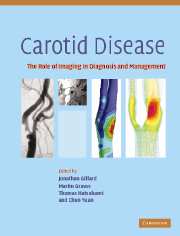Book contents
- Frontmatter
- Contents
- List of contributors
- List of abbreviations
- Introduction
- Background
- Luminal imaging techniques
- Morphological plaque imaging
- Functional plaque imaging
- Plaque modelling
- Monitoring the local and distal effects of carotid interventions
- 25 Transcranial Doppler monitoring
- 26 Imaging carotid disease: MR and CT perfusion
- 27 Near infrared spectroscopy in carotid endarterectomy
- 28 Single photon emission computed tomography (SPECT)
- 29 Monitoring carotid interventions with xenon CT
- Monitoring pharmaceutical interventions
- Future directions in carotid plaque imaging
- Index
- References
28 - Single photon emission computed tomography (SPECT)
from Monitoring the local and distal effects of carotid interventions
Published online by Cambridge University Press: 03 December 2009
- Frontmatter
- Contents
- List of contributors
- List of abbreviations
- Introduction
- Background
- Luminal imaging techniques
- Morphological plaque imaging
- Functional plaque imaging
- Plaque modelling
- Monitoring the local and distal effects of carotid interventions
- 25 Transcranial Doppler monitoring
- 26 Imaging carotid disease: MR and CT perfusion
- 27 Near infrared spectroscopy in carotid endarterectomy
- 28 Single photon emission computed tomography (SPECT)
- 29 Monitoring carotid interventions with xenon CT
- Monitoring pharmaceutical interventions
- Future directions in carotid plaque imaging
- Index
- References
Summary
Introduction
Brain single-photon emission computed tomography (SPECT) has been widely used to assess regional brain perfusion and can also quantify regional cerebral blood flow (CBF) and regional cerebral hemodynamic reserve by measuring cerebrovascular reactivity to acetazolamide. The relationship between the brain perfusion using SPECT and the risk of stroke recurrence in patients with symptomatic carotid disease or the risk for cerebral hyperperfusion or hyperperfusion syndrome after carotid endarterectomy has been investigated.
In this chapter, the utility of SPECT in the evaluation of carotid disease and interventions are discussed.
Cerebrovascular reactivity to acetazolamide and outcome in patients with symptomatic carotid artery occlusion
The hemodynamic effects of an occlusive lesion on the distal circulation have been categorized into three stages (Powers et al., 1987; Derdeyn et al., 1999). Occlusive lesions often have no effect on the distal circulation (stage 0, normal cerebral hemodynamics). When the perfusion pressure distal to the lesion begins to fall, however, reflex vasodilatation maintains normal blood flow (stage 1). This response is known as autoregulation. Autoregulatory vasodilatation can be detected using two basic strategies (Norrving et al., 1982). The first involves quantitative measurements of resting CBF and cerebral blood volume (CBV). CBV increases with autoregulatory vasodilatation and the CBV/CBF ratio, which means the vascular transit time of red blood cells, increases. The second method relies on measurements of CBF at rest and following a vasodilatory stimulus. An absent or diminished response indicates autoregulatory vasodilatation. When autoregulatory vasodilatation is not adequate to maintain normal CBF, CBF begins to fall.
Keywords
- Type
- Chapter
- Information
- Carotid DiseaseThe Role of Imaging in Diagnosis and Management, pp. 387 - 395Publisher: Cambridge University PressPrint publication year: 2006
References
- 1
- Cited by

